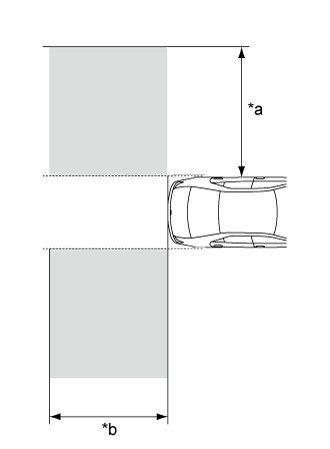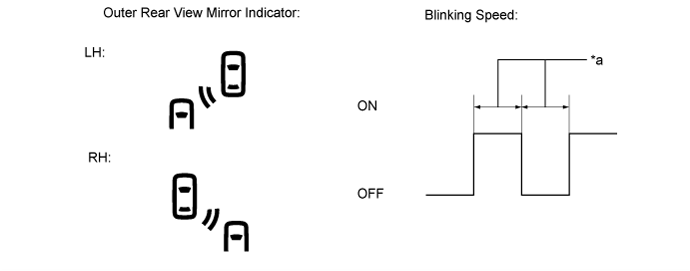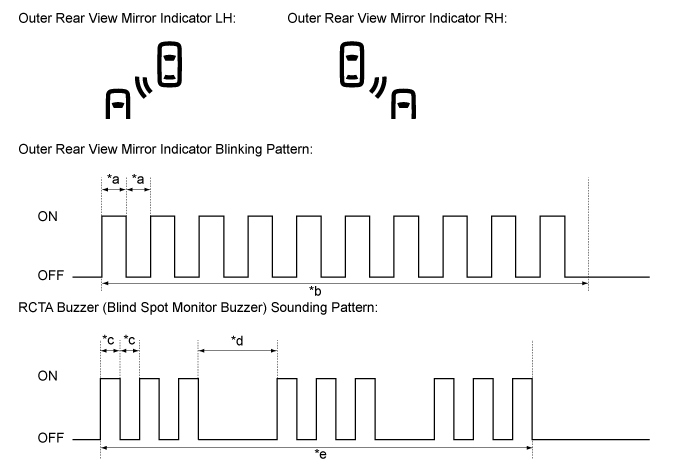Blind Spot Monitor System -- System Description |
| CAN COMMUNICATION SYSTEM |
The blind spot monitor system uses CAN communication to transmit data between the right and left blind spot monitor sensors and each ECU.
If there is a problem in the CAN communication, the right and left blind spot monitor sensors output a CAN communication malfunction DTC.
- for LHD : Click here
- for RHD : Click here
- for LHD : Click here
Each CAN communication line has a particular length and route. Therefore, emergency repair using bypass wiring, etc. is not possible.
- for LHD : Click here
- for RHD : Click here
- for LHD : Click here
| GENERAL |
The blind spot monitor system has a blind spot monitor function and RCTA function.
Blind spot monitor function
- The blind spot monitor function is a function that assists the driver when changing lanes. This function uses quasi-millimeter wave radar to detect vehicles that are traveling in adjacent lanes in the areas that are not visible using the outer rear view mirror assemblies (blind spots) and vehicles that are approaching rapidly from up to 60 m behind this vehicle in the areas that are not visible using the outer rear view mirror assemblies (blind spots). The function advises the driver of the existence of a vehicle by illuminating the outer rear view mirror indicator on the outer rear view mirror assembly.
- If the turn signal switch is operated while the outer rear view mirror indicator on an outer rear view mirror assembly is illuminated, the indicator starts blinking to give additional warning to the driver.
- The blind spot monitor function is a function that assists the driver when changing lanes. This function uses quasi-millimeter wave radar to detect vehicles that are traveling in adjacent lanes in the areas that are not visible using the outer rear view mirror assemblies (blind spots) and vehicles that are approaching rapidly from up to 60 m behind this vehicle in the areas that are not visible using the outer rear view mirror assemblies (blind spots). The function advises the driver of the existence of a vehicle by illuminating the outer rear view mirror indicator on the outer rear view mirror assembly.
RCTA function (w/ RCTA)
- The RCTA function is a function that informs the driver a vehicle is approaching from the left or the right at the rear of the vehicle. The function uses quasi-millimeter wave radar to detect the position and relative speed of other vehicles. When the function determines that a vehicle is approaching this vehicle, this function informs the driver using the outer rear view mirror indicators and blind spot monitor buzzer.
- The blind spot monitor sensor automatically determines whether the vehicle has the RCTA function based on the existence of CAN signals sent from the multi-media module receiver assembly.
- HINT:
- When the vehicle is equipped with the multi-media module receiver assembly, the sensor determines that the RCTA function is present, and when the multi-media module receiver assembly is not equipped, the sensor determines that the RCTA function is not present.
- The RCTA function is a function that informs the driver a vehicle is approaching from the left or the right at the rear of the vehicle. The function uses quasi-millimeter wave radar to detect the position and relative speed of other vehicles. When the function determines that a vehicle is approaching this vehicle, this function informs the driver using the outer rear view mirror indicators and blind spot monitor buzzer.
| FUNCTION OF COMPONENTS |
| Component | Function |
| Blind Spot Monitor Sensor |
|
Outer Rear View Mirror Assembly
| Turns on or blinks the indicator based on a signal from the blind spot monitor sensor. |
Blind Spot Monitor Main Switch (Steering Pad Switch Assembly [Multi-function Switch])
|
|
| RCTA Buzzer (Blind Spot Monitor Buzzer) (w/ RCTA) | Sounds based on a signal from the blind spot monitor sensor. |
Combination Meter Assembly
|
|
| Main Body ECU (Multiplex Network Body ECU) | Transmits the destination information and the dimmer signal to the blind spot monitor sensor via CAN communication. |
Master Cylinder Solenoid
| Transmits the vehicle speed signal to the blind spot monitor sensor via CAN communication. |
| ECM | Transmits the shift position signal (R) to the blind spot monitor sensor via CAN communication. |
| Spiral with Sensor Cable Sub-assembly | Detects the angle of the steering wheel and transmits the resulting signals to the blind spot monitor sensor via CAN communication. |
| Yaw Rate and Acceleration Sensor | Transmits the yaw rate signal to the blind spot monitor sensor via CAN communication. |
| Rear Television Camera Assembly | Receives the blind spot monitor sensor information via CAN communication and sends it to the multi-display assembly through the video signal cable. |
| Multi-display Assembly | Receives the video signals from the rear television camera assembly, and displays RCTA icon on the display panel (w/ RCTA). |
| OPERATION DESCRIPTION |
Operation description of the blind spot monitor function
Operation conditions:
- The blind spot monitor main switch (steering pad switch assembly [multi-function switch]) is on.
- The shift lever is in any position other than R.
- Vehicle speed is more than approximately 16 km/h (10 mph).
- The blind spot monitor main switch (steering pad switch assembly [multi-function switch]) is on.
Conditions in which a sensor can detect a vehicle
The blind spot monitor function indicates detection of a vehicle in the detection area when either condition is met:- When a vehicle is detected in an adjacent lane overtaking this vehicle.
- When a vehicle is detected entering the detection area because it changed lanes.
- HINT:
- The greater the difference in speed between the vehicle and the detected vehicle is, the farther away the other vehicle will be when the notification is given.
- When a vehicle is detected in an adjacent lane overtaking this vehicle.
Detection area
Vehicles in the following areas can be detected:Text in Illustration *a Within Approx. 3.5 m (11.48 ft) from Side of Vehicle *b Within Approx. 1 m (3.28 ft) Forward of Rear Bumper *c Within Approx. 3 m (9.84 ft) Behind Rear Bumper *d Within Approx. 3 m (9.84 ft) to 60 m (196.86 ft) from Rear Bumper 
Detection Area (for Vehicle in Blind Spot) 
Detection Area (for Rapidly Approaching Vehicle from Behind)

Operation description of the RCTA function (w/ RCTA)
Operation conditions:
- The blind spot monitor main switch (steering pad switch assembly [multi-function switch]) is on.
- The shift lever is in R.
- The vehicle speed is less than approximately 8 km/h (5 mph).
- The blind spot monitor main switch (steering pad switch assembly [multi-function switch]) is on.
Conditions in which a sensor can detect a vehicle
The RCTA function indicates detection of a vehicle in the detection area when both conditions are met:- A vehicle is approaching from the right or left at the rear of the vehicle.
- The vehicle speed is approximately 8 km/h (5 mph) to 28 km/h (17 mph).
- A vehicle is approaching from the right or left at the rear of the vehicle.
Detection area
Vehicles in the following areas can be detected:Text in Illustration *a Within Approx. 5.5 to 20 m (18.05 to 65.62 ft) from Side of Vehicle
(detection area changes according to vehicle speed)*b Within Approx. 6 m (19.69 ft) Behind Rear Bumper 
Detection Area

| OPERATION OF OUTER REAR VIEW MIRROR INDICATOR (w/o RCTA) |
Initial check
When the blind spot monitor main switch (combination switch assembly) is turned on with the engine switch on (IG), the outer rear view mirror indicator on each outer rear view mirror assembly illuminates for 3 seconds.
When the engine switch is turned from off to on (IG) with the blind spot monitor main switch (combination switch assembly) on, the outer rear view mirror indicator on each outer rear view mirror assembly illuminates for 3 seconds.
Operation for each function
Operation for blind spot monitor function
- When a sensor detects a vehicle in the blind spot area, the outer rear view mirror indicator on the outer rear view mirror assembly illuminates.
- While the sensor is detecting a vehicle in the detection area and the indicator is illuminated, if the turn signal switch is operated, the outer rear view mirror indicator on the outer rear view mirror assembly starts blinking as shown in the illustration.

Text in Illustration *a 0.125 Seconds - - - When a sensor detects a vehicle in the blind spot area, the outer rear view mirror indicator on the outer rear view mirror assembly illuminates.
| OPERATION OF OUTER REAR VIEW MIRROR INDICATOR AND RCTA BUZZER (BLIND SPOT MONITOR BUZZER) (w/ RCTA) |
Initial check
When the blind spot monitor main switch (steering pad switch assembly [multi-function switch]) is turned on with the engine switch on (IG), the outer rear view mirror indicators on the outer rear view mirror assembly illuminate for 3 seconds and the RCTA buzzer (blind spot monitor buzzer) sounds for 1 second.
When the engine switch is turned from off to on (IG) with the blind spot monitor main switch (steering pad switch assembly [multi-function switch]) on, the outer rear view mirror indicators on the outer rear view mirror assembly illuminate for 3 seconds.
Operation for each function
Operation for blind spot monitor function
- When a sensor detects a vehicle in the blind spot area or a vehicle is rapidly approaching the blind spot from behind the vehicle, the outer rear view mirror indicator on the outer rear view mirror assembly illuminates.
- If the turn signal switch is operated, while the sensor is detecting a vehicle in the detection area and the outer rear view mirror indicator on the outer rear view mirror assembly is illuminated, the indicator starts blinking as shown in the illustration.

Text in Illustration *a 0.125 Seconds - - - When a sensor detects a vehicle in the blind spot area or a vehicle is rapidly approaching the blind spot from behind the vehicle, the outer rear view mirror indicator on the outer rear view mirror assembly illuminates.
Operation for RCTA function
- When all of the operation conditions for the RCTA function are met, the outer rear view mirror indicators on the outer rear view mirror assembly blink for 2.5 seconds and the RCTA buzzer (blind spot monitor buzzer) sounds for 2.3 seconds as shown in the illustration.

Text in Illustration *a 0.125 Seconds *b 2.5 Seconds *c 0.1 Seconds *d 0.4 Seconds *e 2.3 Seconds - - - When all of the operation conditions for the RCTA function are met, the outer rear view mirror indicators on the outer rear view mirror assembly blink for 2.5 seconds and the RCTA buzzer (blind spot monitor buzzer) sounds for 2.3 seconds as shown in the illustration.
When the system is operating and the vehicle is moving in reverse, other vehicles approaching the vehicle are detected and displayed on the multi-display assembly.

Text in Illustration *a Vehicle Approaching from Rear Left *b Vehicle Approaching from Rear Right *c Vehicles Approaching from Rear Left and Rear Right - -